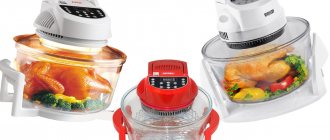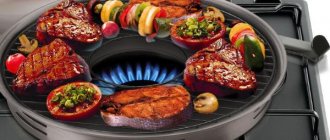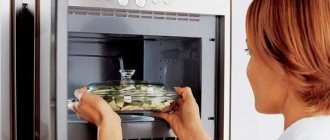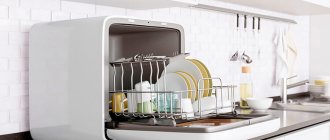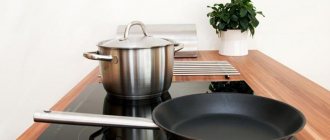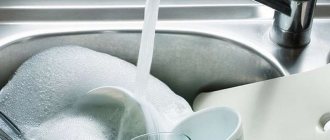The advantages of microwave ovens are undeniable, however, the wrong choice of container can not only damage the device, but also cause harm to health due to food poisoning by released harmful substances. The instructions indicate what kind of dishes can be used in the microwave, but the authors do not have the opportunity to provide for all modifications of the dishes that housewives have. Therefore, knowing what kind of cookware to use will help not only extend the life of the microwave oven, but also avoid health problems.
A special lid prevents food from splashing onto the walls of the oven when heated.
What dishes should not be put in the microwave?
Here is a list of dishes that cannot be used in the microwave:
- Iron utensils , even if they are covered with enamel, and even more so if such utensils do not have an enamel coating. Aluminum and copper are also prohibited. Metal walls are impenetrable to radiation, so the microwave heats the dishes, not the food. Metal utensils cause sparks and damage to the microwave.
- Porcelain and glass containers with a gold rim or pattern . Even if the pattern has been erased over time, the remains will still begin to sparkle. Matte paint also contains metal particles, so it is better to use unpainted utensils.
- Dishes with cracks . Dishes made of porcelain, earthenware, and glass with defects in the form of cracks and chips have a high probability of destruction when heated or removed from the chamber.
- Disposable utensils made from waxed cardboard are undesirable, as melted wax gets into the food. Household members are unlikely to want to eat food prepared with such an additive.
- Crystal products contain metal particles and have walls of uneven thickness. Therefore, if you put a crystal glass in the microwave, it will turn into a pile of fragments.
- Thin glass will not withstand high temperatures and will fall apart right in the chamber.
- A thin film of polyethylene will melt, and if heated in a thick package it will add a specific smell to the dish.
- Dishes with elements or entirely made of wood dry out with the formation of cracks and become charred at high temperatures.
- Cheap types of plastic and varieties that cannot withstand high temperatures.
- Containers made of polyvinyl chloride (PVC) and polystyrene . Only polypropylene (PP) is suitable for microwave use.
- PETE (PET) - polyethylene terephthalate, icon number 1 - cannot be used in the microwave.
- HDPE (HDPE) - high-density polyethylene, icon number 2 - safe for food use, but cannot be used in the microwave.
- PP (PP) - polypropylene, icon number 5 - safe for food use, can be used in the microwave!
Dishes in the microwave should not be covered with tight lids or film - this can lead to an explosion. You should use special lids or film with holes.
Microwave oven and foil dishes
It is forbidden to place dishes wrapped in foil: this also leads to a similar result. Microwave owners should be especially attentive and careful when heating semi-finished products, for example, frozen pizza: such food is often packaged in aluminum foil. Before putting the treat in the microwave, the packaging must be removed.
In some cases, foil is necessary for cooking dishes to prevent individual parts from burning. For such recipes there is a special foil designed for the microwave. This packaging is heat-resistant, its composition differs from ordinary aluminum, and therefore is capable of transmitting microwaves. Often this foil has perforations.
It is not recommended to use ordinary food-grade aluminum foil instead of special one. In addition to sparking, there is another danger: aluminum does not have sufficient heat resistance, so when exposed to waves, the packaging interacts with food. The metal content in food leads to diseases of the liver, kidneys, and nervous system. If you cannot purchase special foil, you can use parchment or a baking sleeve.
What dishes can be put in the microwave?
The size and shape of the dishes are as important as their material, so their choice should be approached responsibly. For heating, low containers are preferable. Utensils for cooking cereals and pasta are needed with a reserve in volume, since water in a microwave oven tends to expand sharply when boiling and splashes over the edge.
In this case, products that expand upward will be optimal. Portioned and large forms are acceptable for baking. Their sides are chosen higher than for ovens, since the rise of dough in the microwave is more active. This primarily applies to yeast dough.
Marking
In every kitchenware store, the buyer is faced with the question: is this or that container suitable for a microwave oven, how to choose the right one? Are there any markings or icons on such utensils? Of course have.
The main marking is an image of a microwave (a row of waves with a tray at the bottom) and the inscription - Microwave safe or Recommended microwave. It is usually located on the bottom. This kind of container will not deteriorate inside a household appliance.
Glassware
This cookware, if fire-resistant or heat-resistant glass is used in its manufacture, is considered ideal. These utensils can be used in the microwave and oven without restrictions. You can cook any dishes you like in it. The shape of the glass does not matter, it doesn’t matter whether the dishes are oval, round or square - the food in them heats up the same way!
It is convenient to have a saucepan with a capacity of 2 liters, the lid of which is used as a shallow plate. The use of thick-walled glasses, salad bowls, and plates made of plain glass is not prohibited if there are no chips or cracks. Placing dishes with a gold rim in a microwave oven is strictly prohibited!
Only the food is heated in the microwave; the dishes should not get too hot.
Recommendations
It is recommended to buy cookware for microwave ovens in specialized stores or from well-known brands that pay attention to the quality of materials and do not forget about labeling. Even if the containers cost more, they will last longer than cheap and fragile ones.
Most oven dishes are best cooked in shallow, but wide, thick-bottomed plates. They provide fast and uniform heating and do not crack from high temperatures.
Microwave lids are subject to the same requirements as plates.
If the microwave oven supports grill or convection mode, food should only be placed in heat-resistant glass containers. Regular quick-heating plates may crack, and plastic ones will begin to release harmful substances.
Silicone utensils for microwave
Silicone microwave cookware does not react to temperature changes and has non-stick properties. You can cook food without oiling it. These microwave-safe dishes can also be used in the oven. The molds purchased must be made by a reputable manufacturer, for example, Taperware. Otherwise, you may become the owner of not only a foul-smelling, but also a dangerous counterfeit.
Food grade plastic
Not every type is suitable for the microwave. Whether the product can be placed in the chamber is indicated on the bottom with the corresponding marking. However, even if there is such a sign, it is better to warm it in a plastic container rather than cook it. Sugar and fat can be heated above the temperature the plastic can withstand, causing it to deform and release volatile compounds.
What else is needed
These are, of course, not dishes, but necessary things:
- special foil. It is needed when there is no lid. Special holes regulate steam exchange. If they are not there, then you need to make several punctures and you can use them;
- lid. A very convenient and necessary thing. It will be useful for the cooking process, where you need to retain moisture and prevent food and fat from splashing, which will make cleaning much easier;
The lid can be either special or improvised, from the same special foil for the microwave or a cardboard disposable plate, and also suitable as a lid: a sheet of clean white paper, a porcelain plate or saucer. Any lid must have a hole; pierce it or place a wooden stick;
- You can also safely use bags (sleeves) for baking. Just don’t fix it with metal parts (clothespins, clamps); use rubber rings, special clips or adhesive tape.
Details on how to clean a microwave.
Products made of porcelain, earthenware and ceramics
These materials are made from clay, so there are no big differences in physical properties. Essentially it is pottery. Porcelain items with a gold rim or pattern should be immediately excluded from permitted use. Why you can’t put them in a cell was said earlier. Unpainted products can be used in microwave mode without restrictions.
Products of this type are sensitive to temperature changes, so before turning on additional functions, the plate must be warmed in microwave mode. Clay dishes get hotter than other types, so when removing them from the chamber you should use an oven mitt or towel. Food takes longer to cook because some of the microwave energy is used to heat the walls.
In glass ceramic containers, food acquires a golden crust. A composition is applied to the bottom of the products, which is heated by microwaves more strongly than the walls. Before cooking, the dishes are placed in the oven for a while to warm the bottom. After which the products are placed. When a crust appears, the process continues with the lid closed. On a glass ceramic plate it is possible to cook a cutlet with an appetizing crust, even without oil.
How to choose a cover
To protect the inner walls of the microwave from splashes during cooking, use a special microwave cover. It comes in two types – glass and plastic.
The plastic model has a special valve for steam release and can be used at temperatures up to 110°C. There is usually a wide, comfortable handle on top of the lid. This kitchen appliance product is safe for health and can be easily washed by hand or in the dishwasher. Protects baked goods and other food from chapping and helps retain heat.
Paper, polystyrene foam, cling film
Such materials are used for packaging semi-finished products. If they have holes for steam to escape, the microwave will heat the contents to the desired temperature. Otherwise, an explosion may occur. The original packaging should have a symbol indicating that it can be placed in a microwave oven. Small quantities of food (for example, a sandwich) can be heated in parchment paper, a linen napkin, or in a special porous bag.
You can determine which dishes are suitable for the microwave yourself. Take a thick-walled glass glass, preferably faceted, fill it with water and place it in the container to be tested. After a minute of heating in the oven at maximum power, the water heats up, but the usable container remains cold. If the dishes are very hot, do not use them.
Disposable packaging
Today, our busyness allows us to buy and heat up quick semi-finished products. Is it possible to cook your favorite cheburek without removing the packaging?
It is possible, but only with microwave film: whether it is such, the manufacturer writes on the packaging.
For example, a baking sleeve. This material can be used in any mode. Tip: make several steam vents. Otherwise, the bag will explode, and instead of a delicious lunch you will have to start cleaning.
Styrofoam containers can be heated with food only if there are corresponding icons on the bottom and lid.
Paper packaging is suitable for cooking and heating dishes with a low content of oil, water, and sugar.
Cardboard glasses and bowls coated with wax for durability are only suitable for heating and only in microwave mode, power up to 800 W.

